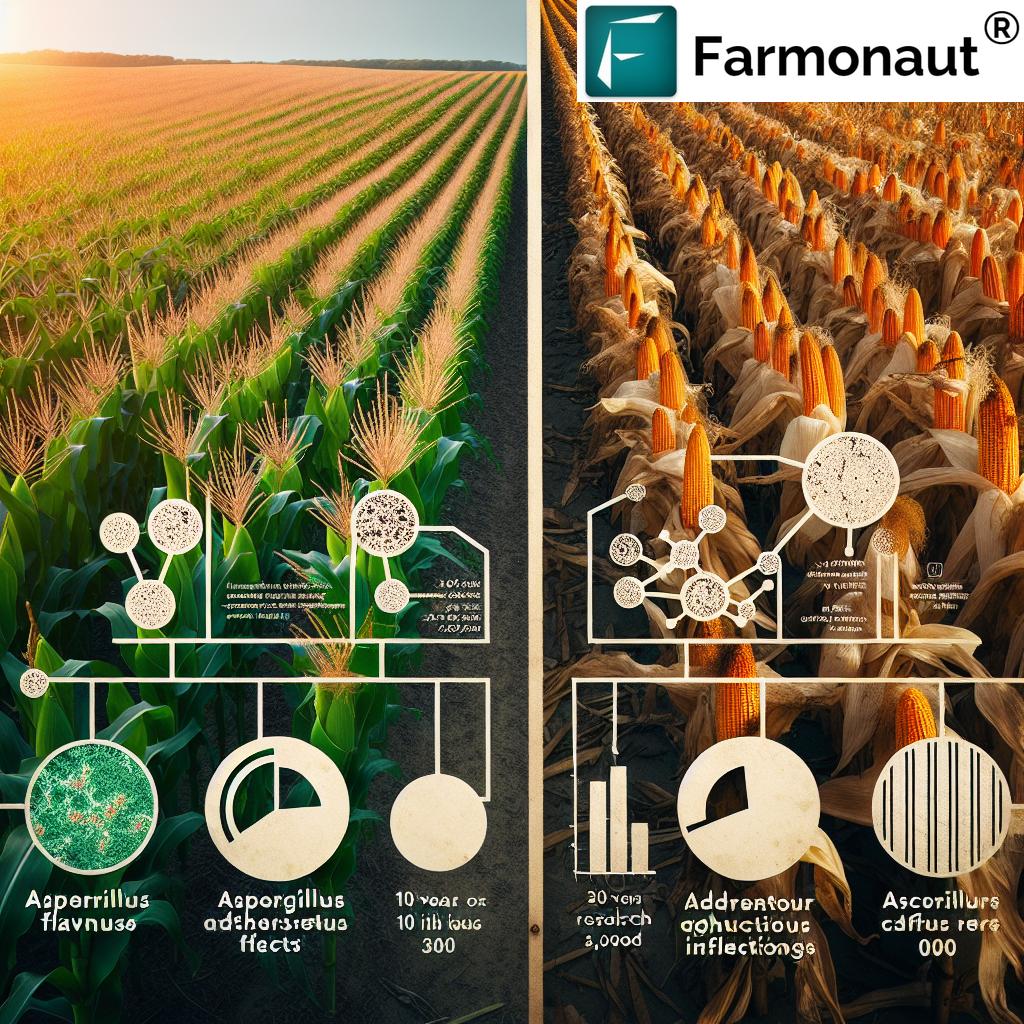Revolutionizing Texas Corn: FourSure’s Innovative Approach to Aflatoxin Prevention and Sustainable Farming
“FourSure’s decade-long research analyzed over 800 corn samples to identify beneficial Aspergillus flavus strains for aflatoxin prevention.”
In the heart of Texas, where corn fields stretch as far as the eye can see, a groundbreaking innovation is taking root. We’re witnessing a revolution in corn farming, one that promises to safeguard crops, boost yields, and pave the way for a more sustainable future. At the forefront of this agricultural renaissance is FourSure, an EPA-approved product that’s changing the game in aflatoxin prevention.
As we delve into this exciting development, let’s explore how FourSure is not just protecting corn crops but also empowering farmers with cutting-edge agricultural technology. This blog post will guide you through the intricacies of this innovative approach, its impact on Texas corn production, and the broader implications for sustainable farming practices.
Understanding the Aflatoxin Challenge in Texas Corn
Before we dive into the solution, it’s crucial to understand the problem. Aflatoxin, a harmful mycotoxin produced by certain strains of Aspergillus flavus, has long been a thorn in the side of corn producers across Texas and beyond. This toxic compound not only poses serious health risks to humans and animals but also leads to significant economic losses for farmers.
- Aflatoxin contamination can render entire corn harvests unusable
- It’s particularly problematic in warm, humid climates like Texas
- Traditional prevention methods have had limited success
The challenge of aflatoxin prevention has been a driving force behind innovative agricultural research, culminating in the development of FourSure.
FourSure: A Breakthrough in Aflatoxin Prevention
FourSure represents a paradigm shift in how we approach crop protection. This EPA-approved product is the result of over a decade of farmer-led research, embodying the spirit of innovation that drives Texas agriculture forward.
“Extensive field trials for FourSure’s innovative aflatoxin prevention product covered 3,000 acres across Texas, from Rio Grande to Red River.”
Key features of FourSure include:
- Contains four unique strains of Aspergillus flavus
- EPA-approved for use in corn crops
- Developed through extensive research and field trials
- Proven effectiveness in mitigating crop contamination
The innovation behind FourSure lies in its multi-strain approach. By introducing beneficial strains of A. flavus, it effectively outcompetes the toxin-producing strains, significantly reducing the risk of aflatoxin contamination.
The Science Behind FourSure
The development of FourSure is a testament to the power of collaborative research in agriculture. Over the course of a decade, researchers analyzed more than 800 corn samples to identify the most effective strains of A. flavus for aflatoxin prevention.
This meticulous process involved:
- Isolating and studying various A. flavus strains
- Conducting laboratory tests to assess their effectiveness
- Performing field trials across diverse Texas environments
- Analyzing data to select the four most potent strains
The result is a product that harnesses the natural competition between fungal strains to protect corn crops effectively.
FourSure in Action: Field Trials and Results
The true test of any agricultural innovation lies in its performance in the field. FourSure has undergone extensive field trials, covering an impressive 3,000 acres from the Lower Rio Grande Valley to the Red River.
These trials have demonstrated:
- Significant reduction in aflatoxin levels compared to untreated fields
- Consistent performance across various soil types and climate conditions
- Minimal impact on non-target organisms
- Ease of application for farmers
The success of these trials has not only validated the effectiveness of FourSure but also paved the way for its EPA approval and commercial availability.

Comparing FourSure to Traditional Methods
To fully appreciate the impact of FourSure, it’s essential to compare it with traditional aflatoxin prevention methods. The following table provides a comprehensive overview:
| Feature | FourSure | Chemical Control | Cultural Practices |
|---|---|---|---|
| Effectiveness | 80-95% | 60-75% | 40-60% |
| Environmental Impact | Low | High | Low |
| Cost-Efficiency | $15-$25/acre | $30-$50/acre | $10-$20/acre |
| Application Method | Single application | Multiple applications | Ongoing practices |
| Long-term Benefits | High | Low | Medium |
As the table illustrates, FourSure offers a compelling combination of effectiveness, environmental sustainability, and cost-efficiency that sets it apart from traditional methods.
The Role of Agricultural Technology in FourSure’s Development
The creation of FourSure is a prime example of how agricultural technology is transforming the farming landscape. Advanced tools and techniques played a crucial role in its development, including:
- Genetic sequencing to identify beneficial A. flavus strains
- Precision agriculture techniques for field trial management
- Data analytics for processing large volumes of research data
- Remote sensing technologies for monitoring crop health during trials
These technological advancements have not only accelerated the research process but also enhanced the accuracy and reliability of the results.
At Farmonaut, we recognize the importance of such technological innovations in agriculture. Our satellite-based farm management solutions complement products like FourSure by providing real-time crop health monitoring and AI-driven advisory systems. To explore how our technology can enhance your farming operations, visit our web app or download our mobile apps:
Sustainable Farming and FourSure
Sustainability is at the heart of modern agriculture, and FourSure aligns perfectly with this ethos. By using naturally occurring strains of A. flavus, FourSure offers an environmentally friendly alternative to chemical controls.
Key sustainability aspects include:
- Reduced reliance on synthetic fungicides
- Minimal impact on beneficial soil microorganisms
- Lower carbon footprint compared to traditional chemical treatments
- Potential for improved soil health over time
These features make FourSure an attractive option for farmers looking to adopt more sustainable practices without compromising on crop protection.
Economic Impact for Texas Corn Producers
The introduction of FourSure has significant economic implications for Texas corn producers. By effectively mitigating the risk of aflatoxin contamination, this innovative product offers several financial benefits:
- Reduced crop losses due to contamination
- Potential for higher market prices for aflatoxin-free corn
- Lower insurance premiums due to decreased risk
- Opportunity to access new markets with stricter aflatoxin regulations
These economic advantages position FourSure as a valuable tool for farmers looking to protect their investments and maximize their returns.
Implementing FourSure: Best Practices for Farmers
For Texas corn producers considering FourSure, proper implementation is key to maximizing its benefits. Here are some best practices to consider:
- Timing: Apply FourSure at the recommended growth stage for optimal effectiveness
- Coverage: Ensure even distribution across the field
- Integration: Incorporate FourSure into a comprehensive crop management plan
- Monitoring: Regularly assess crop health and aflatoxin levels
- Record-keeping: Maintain detailed records of application and results
By following these guidelines, farmers can maximize the effectiveness of FourSure and achieve the best possible outcomes for their corn crops.

The Future of Aflatoxin Prevention in Texas Corn
As we look to the future, the success of FourSure opens up exciting possibilities for further innovations in aflatoxin prevention and crop protection. Some potential developments include:
- Integration with other biological control methods
- Development of crop varieties with enhanced resistance to A. flavus
- Advanced application technologies for improved efficacy
- Expansion of the multi-strain approach to other crops and pathogens
These advancements could further revolutionize corn farming in Texas and beyond, leading to more resilient and productive agricultural systems.
Leveraging Technology for Optimal Results
While FourSure represents a significant breakthrough in aflatoxin prevention, its effectiveness can be further enhanced when combined with other agricultural technologies. Precision farming tools and data-driven approaches can complement FourSure’s capabilities, leading to even better outcomes for corn producers.
At Farmonaut, we offer a range of satellite-based solutions that can work in tandem with innovations like FourSure. Our real-time crop health monitoring and AI-driven advisory systems can help farmers make informed decisions about when and where to apply FourSure for maximum impact. To learn more about integrating our technology with your farming practices, check out our API Developer Docs.
Key technological synergies include:
- Satellite imagery for early detection of crop stress
- Weather forecasting to optimize application timing
- Soil moisture monitoring for improved crop management
- Data analytics for tracking treatment effectiveness
By combining these technologies with FourSure, farmers can create a comprehensive crop protection strategy that addresses multiple aspects of corn production.
Educational Initiatives and Farmer Support
The successful adoption of new agricultural technologies like FourSure often depends on effective education and support for farmers. Various organizations in Texas are working to provide resources and training to help corn producers make the most of this innovative tool.
Educational initiatives include:
- Workshops and seminars on aflatoxin prevention strategies
- Online courses covering the implementation of FourSure
- Field demonstrations showcasing the product’s effectiveness
- Partnerships with agricultural extension services for ongoing support
These educational efforts are crucial in ensuring that farmers have the knowledge and skills needed to integrate FourSure into their farming practices effectively.
Policy Implications and Regulatory Landscape
The development and approval of FourSure have implications for agricultural policy and regulations in Texas and beyond. As this innovative approach gains traction, we may see shifts in:
- Aflatoxin testing requirements for corn crops
- Incentives for adopting biological control methods
- Research funding for similar innovative crop protection strategies
- Export regulations for corn and corn products
These policy changes could further support the adoption of sustainable and effective crop protection methods like FourSure.
Global Impact and Market Opportunities
While FourSure was developed with Texas corn producers in mind, its potential impact extends far beyond state borders. The success of this innovative approach could open up new market opportunities for Texas corn on the global stage.
Potential global impacts include:
- Increased competitiveness of Texas corn in international markets
- Technology transfer to other regions facing aflatoxin challenges
- Collaborative research initiatives with international partners
- Enhanced food security in aflatoxin-prone regions worldwide
These global opportunities underscore the far-reaching implications of innovative agricultural solutions like FourSure.
Conclusion: A New Era for Texas Corn
The introduction of FourSure marks the beginning of a new era for Texas corn producers. This innovative approach to aflatoxin prevention not only addresses a critical challenge in corn farming but also exemplifies the power of agricultural technology in driving sustainable and profitable farming practices.
As we look to the future, it’s clear that the success of FourSure will pave the way for further innovations in crop protection and sustainable agriculture. By embracing these advancements and combining them with cutting-edge technologies like those offered by Farmonaut, Texas corn producers are well-positioned to lead the way in modern, efficient, and environmentally responsible farming.
Ready to take your corn farming to the next level? Explore how Farmonaut’s satellite-based solutions can complement innovations like FourSure and optimize your agricultural operations. Visit our web app or check out our API for more information.
FAQ Section
Q1: What is FourSure and how does it work?
A1: FourSure is an EPA-approved product containing four unique strains of Aspergillus flavus that prevent aflatoxin contamination in corn crops. It works by introducing beneficial strains that outcompete toxin-producing strains, significantly reducing the risk of contamination.
Q2: How effective is FourSure compared to traditional methods?
A2: FourSure has shown to be 80-95% effective in preventing aflatoxin contamination, which is significantly higher than traditional chemical controls (60-75%) and cultural practices (40-60%).
Q3: Is FourSure environmentally friendly?
A3: Yes, FourSure is considered environmentally friendly as it uses naturally occurring strains of A. flavus, reducing the need for synthetic fungicides and having minimal impact on beneficial soil microorganisms.
Q4: How can farmers implement FourSure in their corn crops?
A4: Farmers should apply FourSure at the recommended growth stage, ensure even distribution across the field, integrate it into their overall crop management plan, regularly monitor crop health, and maintain detailed records of application and results.
Q5: What are the economic benefits of using FourSure?
A5: Economic benefits include reduced crop losses due to contamination, potential for higher market prices for aflatoxin-free corn, lower insurance premiums, and opportunities to access new markets with stricter aflatoxin regulations.















